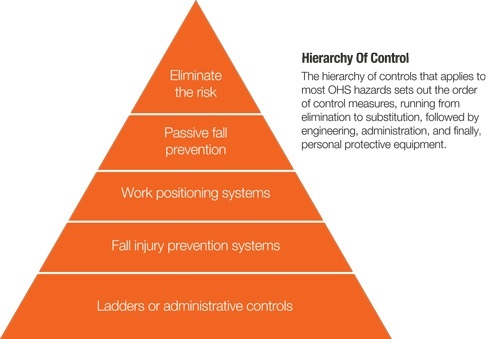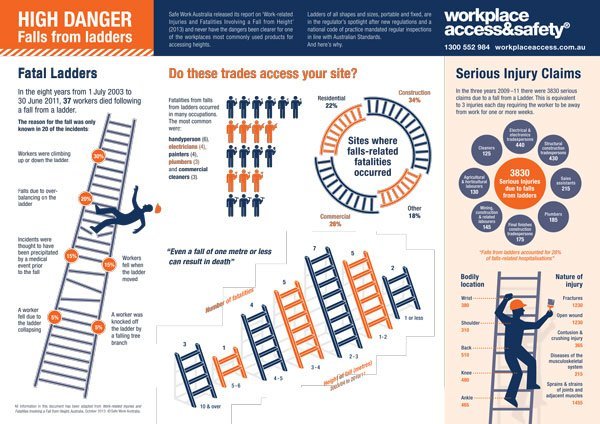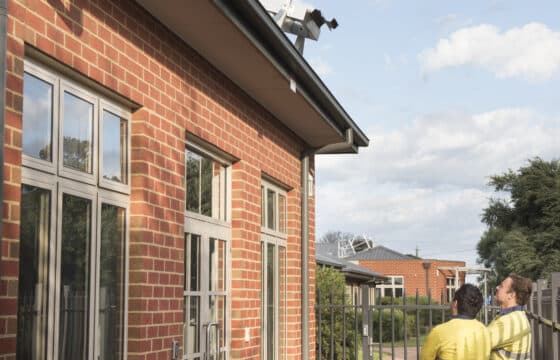WorkSafe Blitz on Ladders
Key points to consider to satisfy WorkSafe
• Is a ladder in use at your workplace?
• Is it the appropriate tool for the job?
• Is your workplace using ladders correctly?
• Are the ladders inspected and in a suitable condition?
The use of portable ladders is the focus of site blitzes by the workplace regulator in Victoria.
Announcing the targeted blitz, Minister for Workplace Safety Jill Hennessy said,
Too many Victorians are not making it home to their friends and families after falling from portable ladders – and dozens more have been injured. This blitz is about ensuring employers are doing the right thing by their staff.
WorkSafe, the OHS policing body published a paper outlying their expectations and blitz in September. The communication stipulates that ladders should be appropriate for the job and must be used correctly.
The announcement is timely, following three deaths in Victoria this year and given that ladders are the number one cause of fatalities due to falls from heights .
Launching the initiative in October, WorkSafe Executive Director Health and Safety Julie Nielsen said
Address these three questions, and you’ll make any one of WorkSafe’s inspectors happy.
1. Is a ladder in use? Is it the right tool for the job?
Questioning whether a ladder is the right tool for the job is appropriate. The prevention of falls hierarchy say that a ladder may only be used after considering the first 4 levels of the hierarchy of control measures for fall prevention.
This applies to working on ladders and the use of portable ladders for access and egress to the work area.
WorkSafe’s release says
Portable ladders are one of the least stable tools for work at height and for providing access to platforms.
This means that other types of access should be explored before resorting to portable ladders for access, egress and work.

Next steps to take:
- Explore whether a fixed step or rung type ladder is better suited to get to the work area.
- Is an alternate surface better suited to the task such as a level work platform or scaffold?
2. Is your work site using ladders correctly?
Portable and rung type ladders are primarily designed for access and egress. They are designed to be climbed using two hands, which means that carrying tools and equipment is misuse of the ladder.
WorkSafe’s release states that
Users must always be able to maintain 3 points of contact.
Theoretically, equipment should be roped up separately. This involves the worker harnessing off at the top to an anchor, securing the area below and then hoisting a rope attached to their tools and equipment. In practise, this means two workers showing up on site with bollards, ropes, anchors, harnesses, lifting gear, paperwork and lots of time. In the real world of one person facilities maintenance or high paced construction, this seldom happens. This means that a worker generally climbs a ladder with say tools or a gas bottle in one hand whilst holding on with the other.
The solutions could be
- Use fixed type access like step type ladders or stairways which are better suited to carrying equipment whilst maintaining attachment.
- Use separate systems of hoisting equipment comprising a crane, davit or forklift.
The means of mitigating risks are dependent on task, frequency, worker competency, work environment, job duration and exposure to risk. A knowledge of practical risk mitigation measures, availability and cost factors is critical given commercial realities
3. Are the ladders inspected and in a suitable condition?
The 2013 Regulators guidance note entitled “Selection and Safe Use of Portable Ladders” is widely referenced in the blitz release.
Worksafe says
Ladders should be regularly inspected and maintained by a competent person to make sure they are safe to use.
Eleven different inspection items and fifteen possible defects are prescribed for maintenance inspections, in addition to the standard compliance items relating to Australian standards AS1657 and AS/NZS1892.
AS1657 deals with four different generic types of fixed ladders and the AS/NZS1892 series deals with different types of portable type ladders.
To comply with WorkSafe’s requirements and to establish whether the ladder condition is suitable and passes,
- inspect all of the critical items against a checklist and maintain a register against the asset number.
- Tag the ladder so that it is easily identifiable as inspected and future inspection dates are clear.
The three steps are the key to practical safety and compliance
Falls from ladders are the number one cause of workplace deaths due to falls from height in Australia. Following the three steps and WorkSafe’s requirements together with AS/NZS1892 and AS1657 goes a long way towards saving lives.
Together, they spell out sensible height safety rules that make it clear how workplaces can increase the safety of workers at the lowest possible cost while minimising legal liability.
About the author:
Carl Sachs is Director of Workplace Wing, the advisory arm of the Workplace Access & Safety Group. When Carl isn’t being lectured to by NATA, CodeMark and his four sons, he provides advice to the Wallabies, Workplace regulators, Government and Corporates. Sadly, the Wallabies don’t listen.



